Glass.

[ GLASS ]
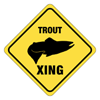
about cam2

[ GLASS ]

about cam2

If you missed predictions 7-12, read part one 1 of Frog‘s tech trend forecast for 2012. [via Fast Co.]
6. Low-End Mobile Innovation
Smartphones will make significant inroads into an entirely new segment: the lower end of the mass market and the “base of the pyramid.” Huawei’s sub-$100 Android smartphone has already had significant success in Kenya, and major manufacturers are quickly following suit across Africa, India, Southeast Asia, and South America. These cellphones will not be notable for hardware innovations, as they’re stripped-down versions of their more expensive and feature-packed brethren. However, they’ll be notable for the fact that an eager population will be discovering the world of mobile technology and apps for the first time. This population is filled with experimenters, tinkerers, and developers who will unleash a new world of apps that address their own needs and pain points–those that have gone ignored by the companies catering to the top end of the market.
5. Interaction Becomes Gestural
User interaction with technology is going above the glass. You no longer need an explicit tool or even direct manipulation to drive a user interface. With the ability of technology, like Microsoft Kinect, to see users’ movements in space, gestures are being added to traditional methods in new layers of interaction. Designing with this in mind requires new thinking about dexterity, ergonomics, and whether someone might feel silly or offensive with certain gestures. We are so involved in this space right now that we’ve had to move our design technologists’ desks to create enough room for all the hand-waving movements.
4. Flourishing Commerce in the Post-PC Era
We will likely see firms convert their successful web experience to a more streamlined mobile and tablet capability. But as consumers’ experiences with these rapidly evolving post-PC platforms mature, they will expect much more. The post-PC platform affords mobility, portability, payment capabilities, video and collaboration, location awareness, natural language processing, gestures, and so on. Clever firms will wield this fresh and evolving palette to craft engaging experiences in the real and virtual worlds. The aim will be to drive customer delight, loyalty, and engagement.
3. Remote Collaboration
Given the demand for more connectivity between both people and places, it feels like technology is far behind in addressing the need to work efficiently and with the same “directness” of talking to a person in the same room. We are so far away from a high-def experience that we may want to reconsider sending a smoke signal. Make no mistake, technology is moving fast, as shown by the popularity of Skyping with friends and family across continents. Unfortunately, the truth is that most of our conversations across distances are far from perfect and no fun at all. We need creative collaboration between design and technology to rethink these experiences so that they are more fulfilling and “direct” activities in our lives.
2. Biomimicry
We’ll see increasing numbers of scientists, technologists, architects, corporations, and even governments looking to biomimicry–designing objects and systems based on or inspired by patterns in nature–as an efficient innovation strategy. Why? Often, nature can provide examples of energy-saving, environmentally friendly solutions to a variety of technological challenges. These solutions have also been “tested” via billions of years of informal R&D–by animals, plants, insects, and other participants in the natural world who have come up with ways of harvesting water from fog, for example, or possess sleek forms that are more aerodynamic than traditional man-made ones.
1. Reshape: Humans Are Analogue
The way of design is only achievable via creative model-making and prototyping by the designer. Tools, both real and virtual, connect our mind with the real world. However, tools also define how we shape things: Tools’ limitations enhance our deep involvement with them and the materials, and honing our skills ultimately leads to mastership. The curse of “easy” digital tools is to become complacent after relative early “successes.” This can lead to mediocrity and a loss of creative excellence. Like the new “polystyrene slates” of many new electronic products, where excellence is defined by how well the corners are shaped (a re-run of 1950s boxy design), our modern-day digital design software is the cause for zillions of repetitive and bland products. Charlie Chaplin’s classic film of mechanized dehumanization, Modern Times, is a déjà vu of our current state.
Have some predictions of your own? Let us know about them in the comments.
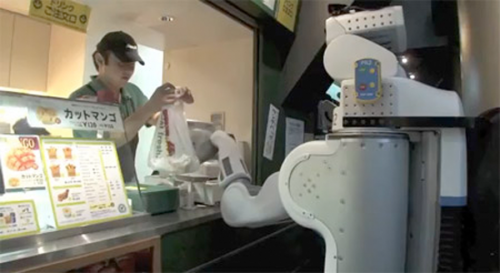
The University of Tokyo and Technische Universität München, uses semantic search to task a PR2 robot with fetching a sandwich. The PR2 has no detailed information on sandwiches, but its database tells it that sandwiches are a type of food, and that food can be found in kitchens and restaurants, its database also has maps and locations, and from that, it figures out where to look. The robot has to figure out how to find and use an elevator to a lower level where a Subway is located.
“Semantic search” is the process of deriving logical conclusions from premises known or assumed to be true. In this example it’s a computerized version of what we humans think of as “common sense.” For example, if someone asks you to bring them a glass without telling you exactly where the glass is, you’re probably smart enough to infer that a glass can be found in cabinets or dishwashers, and cabinets and dishwashers are typically located in a kitchen, so you can go to the kitchen, poke around a bit, and find a glass.
[ willow garage ]



NASA unveils three concept designs for aircraft that could be ready to fly by 2025.
NASA appears to want development of a line of super-planes that are larger, faster, quieter and burn fuel slower and cleaner than today’s commercial aircraft. The three designs — from Northrop Grumman, Boeing, and Lockheed Martin — are part of a set of contracts to study advanced concept designs for airplanes that will eventually replace the planes flown today. “Each design has to fly up to 85 percent of the speed of sound; cover a range of approximately 7,000 miles; and carry between 50,000 and 100,000 pounds of payload, either passengers or cargo” all while producing “less noise, cleaner exhaust and lower fuel consumption.”
Other concepts at various stages of development below:
resources:
NASA press article
enjoy space
http://www.nasa.gov/topics/aeronautics/features/flight_2025.html
design education is as important to the future of the economy as the sciences, technology, mathematics and engineering, and should be given equal support. via theguardian [RK]
 August is “vacation month” worldwide.
August is “vacation month” worldwide.
With global warming threatening coastal cities and a new era of mass migration on the horizon, going mobile just might be today’s bright idea – and tomorrow’s way of life. Here are a dozen tech-packed trailers you can browse on your laptops while the kids play in the water.
Rolling stone.
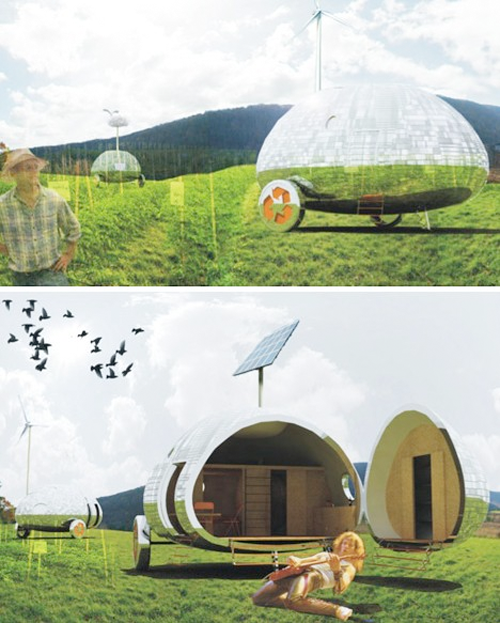
above: (images via: Dornob and Inhabitat)
Slovakia-based Nice Architects has a nice idea for future mobile-homers: the Rolling Stone eco-capsule. Though not connected in any way with a certain English music group, a certain American pop culture magazine or a song by a certain singer named Bob Dylan, the Rolling Stone stands on its own when it comes to being environmentally friendly, self-sufficient and generally cute & cozy.
above: (images via: Balleride and Core77)
Those who wouldn’t be caught dead in a classic, Harvest Gold motor home might find the svelte & stylish Mehrzeller much more appealing. German for “multi-cell”, the Mehrzeller caravan concept maximizes interior space while displaying an organic, polygon exterior that resembles natural mineral crystals. The Mehrzeller hails from Graz, Austria, birthplace of another svelte & stylish object: California “Governator” Arnold Schwarzenegger.
above: (images via: All Hydrogen Cars and Fotki)
The 2030s, that is. Actually the Airstream concept Ford’s been showing off lately looks both ways: its eco-friendly hybrid hydrogen fuel cell is most futuristic while the silvery style and iconic name harken back to the good old dust bowl days when hydrogen power was all the rage… until that idea went down like a lead zeppelin.
Foldoub trailer
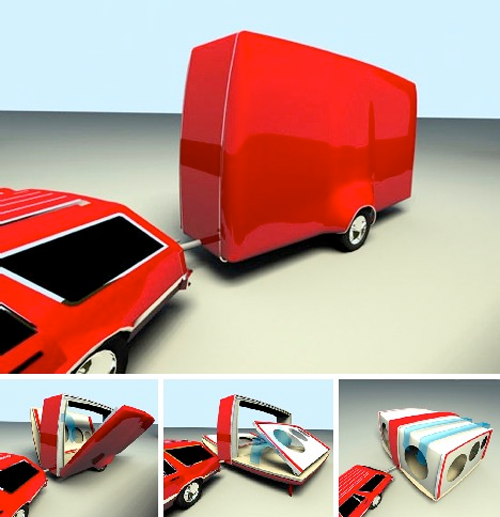
above: (images via: Treehugger)
Dutch designer Niels Caris has created a foldout trailer called, naturally, the Foldoub Trailer. Tow, park, push a switch and the whole kit & kaboodle opens up like Godzilla’s big pop-up book of home design. On the downside, the Foldoub Trailer has no kitchen, bathroom or storage… which could be a problem if you’re parked 50 miles past the “100 miles to Next Gas & Lodging” sign.
above: (images via: Busyboo and Yanko Design)
The 252° Living Area springs from the creative mind of French designer Stephanie Bellange. Small enough to be towed by a Mini, the 3-wheeled trailer features supporting feet that spread automatically once the trailer’s outside shell is opened. The interior parts follow, much like the petals of a blossoming flower.
above: (images via: Trendbird and Luxist)
The Colim Modular Camper is a car, a trailer and a motorhome all in one. Park at your campsite, then tour the sites in the two-seater convertible module. The interior lives up to the exterior’s promises as well, with flowing, organic surfaces and eye-pleasing colors – not a splinter of plastic wood anywhere. The Colim Modular Camper is eco-friendly as well, with a solar panel on the roof and a hybrid engine nestled under the hood.
above: (images via: Squob and DesignApplause)
The T@B XL takes the classic teardrop trailer concept and lifts it into a new level of luxury. T@B’s (pronounced “Tab”) lesser models are anything but trashy but the twin-axle XL definitely rules the roost. Sleekly styled, the XL still stretches 22 feet from stem to stern and is expected to be priced in the $60K range. That is, if manufacturer Knaus Tabbert manages to emerge from bankruptcy – times are tough for the purveyors of luxo-goods.
above: (images via: Carscoop and American Custom Trailers)
You’ve seen cars towing motorcycles, but how about ‘cycles towing cars? They may be scaled down a mite but these very cool trailers still evoke the spirit of pinstriped, big-tired muscle cars. Mustangs and Corvettes are featured but the manufacturer, American Custom Trailers, also takes custom orders.
above: (images via: Gear)
The Sylvan Sport GO trailer looks like a comfy pop-up camping trailer at first glance but the more you look, the more you see. Indeed, versatility is the Sport GO’s middle name. Weighing in at 800 lbs., the camper morphs into an ATV hauler, a camping gear hauler, basically whatever you need it to do. Calling it the Transformers of pop-up campers would be an understatement, though the Sport GO seems to be the non-combative type. Here’s a video of the Sylvan Sport GO in action:
The Sylvan Sport GO, via PCTV1
above: (images via: World’s Fair Community and Gizmag)
This intimidating mobile home concept from General Motors Advanced Design Group shows the beleaguered corporation isn’t bankrupt – at least when it comes to provocative ideas. The GMC PAD is sort of a Winnebago on steroids that sports 6 wheels, an enormous full length (and width) windshield and a curious articulating feature that extends a step-like device out from the, er, fuselage to ease entry and exit. The PAD runs on a diesel-Electric hybrid system and its innovative resource management technology ensures onboard fuel and water supplies will last weeks, even months.
above: (images via: Find A Property)
The Tumbleweed Tiny Home Company has got a good thing going. These tiny perfect houses come mounted on wheels, so by law they’re considered travel trailers and thus a building permit isn’t required. Tiny they are, however: could you live in 65 to 140 square feet of space without padding the walls?
above: (images via: Design Art Book)
The Capsule Caravan may look lke an oversized M&M but there’s nothing nutty about what’s inside. British designer David Tonkinson engineered the ovoid trailer to separate into distinct Comfort and Service Pods to keep men and machines apart. Conceived as a way to take in summer music festivals by day while resting comfortably by night, the Capsule Caravan is one of the sharpest trailers around – and that’s saying something as it’s one of the smoothest designs going.
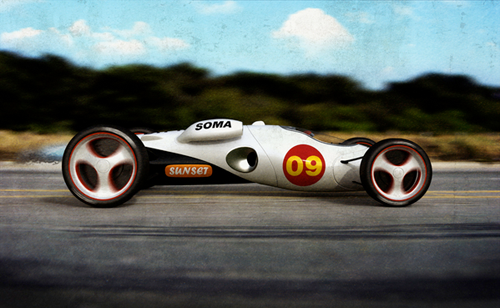 Talented designer, stylist, and illustrator.
Talented designer, stylist, and illustrator.
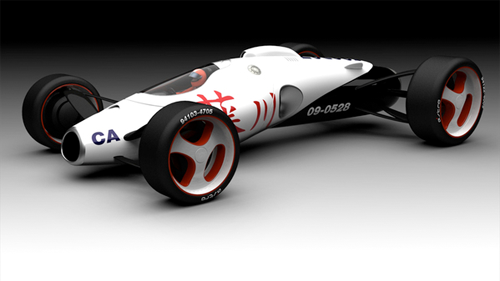
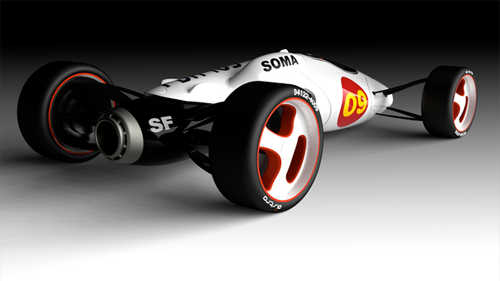

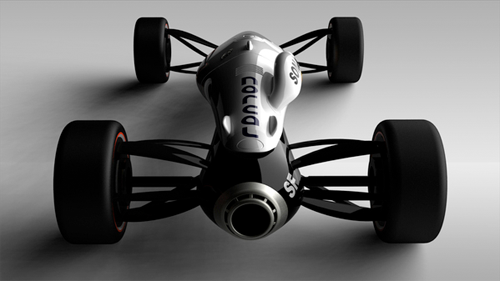
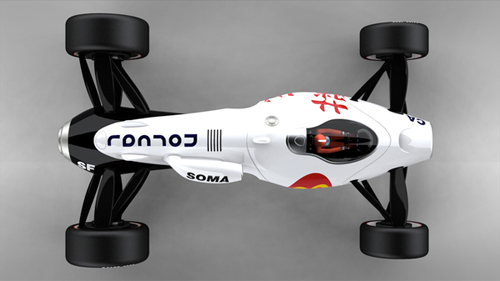
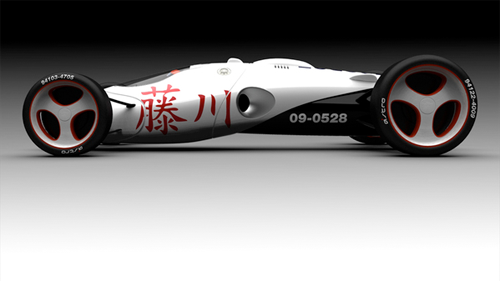
Designer: Norio Fujikawa
This video’s been around, but now slightly updated. Still fascinating.
All content ©2007 > 2024 DesignApplause